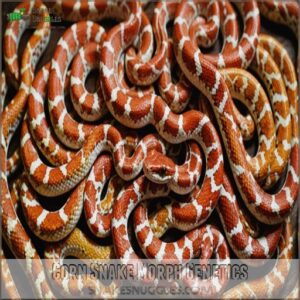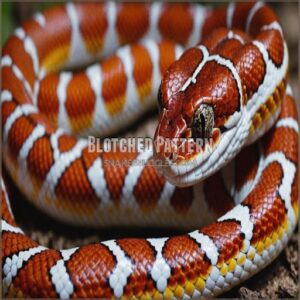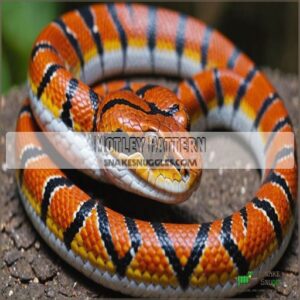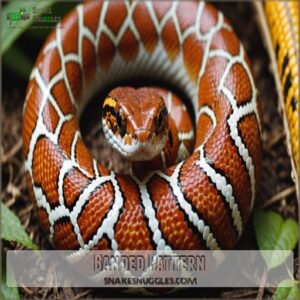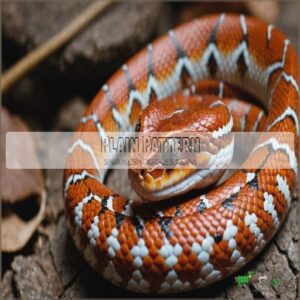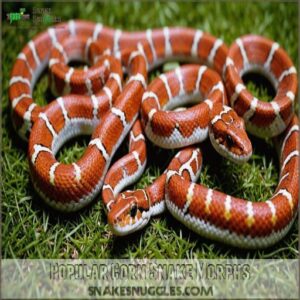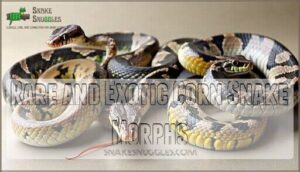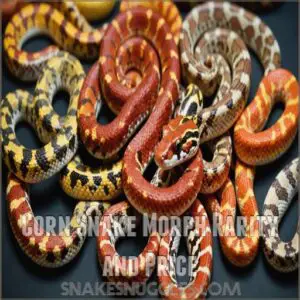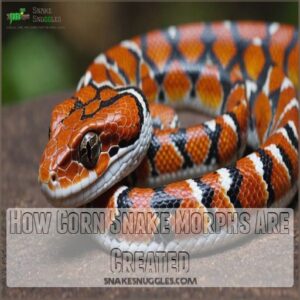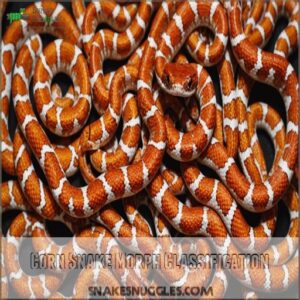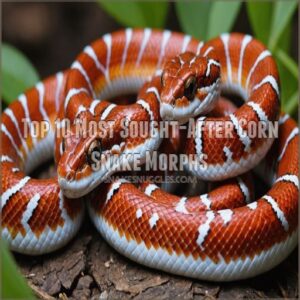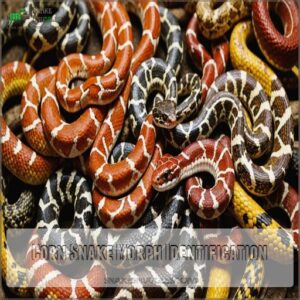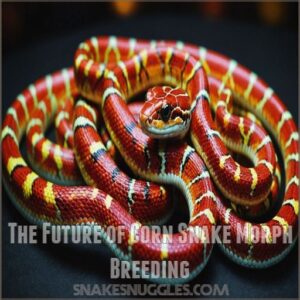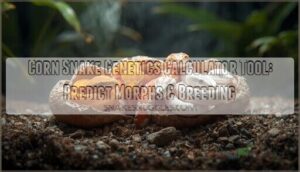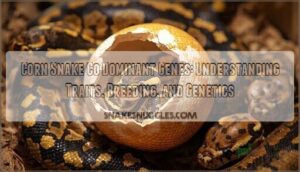This site is supported by our readers. We may earn a commission, at no cost to you, if you purchase through links.
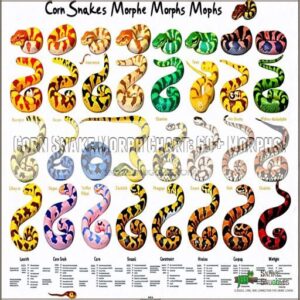 Exploring the corn snake morph chart is like stepping into an artist’s studio, where nature paints with the finest palette of colors and patterns.
Exploring the corn snake morph chart is like stepping into an artist’s studio, where nature paints with the finest palette of colors and patterns.
With over 60 morphs, this chart serves as your trusty map, guiding you through the vibrant world of corn snake genetics.
From the striking red of the Red Coat Morph to the subtle elegance of the Snow Morph, each trait and pattern tells its own genetic tale.
Whether you’re a seasoned herpetologist or just starting out, decoding these morphs reveals the beauty and intricacy of selective breeding.
Curious about those rare morphs? There’s plenty more to uncover!
Table Of Contents
- Key Takeaways
- Corn Snake Morph Genetics
- Types of Corn Snake Morph Patterns
- Popular Corn Snake Morphs
- Rare and Exotic Corn Snake Morphs
- Corn Snake Morph Rarity and Price
- How Corn Snake Morphs Are Created
- Corn Snake Morph Classification
- Top 10 Most Sought-After Corn Snake Morphs
- Corn Snake Morph Identification
- The Future of Corn Snake Morph Breeding
- Frequently Asked Questions (FAQs)
- What is the rarest corn snake morph?
- What are the colors of corn snakes morphs?
- What are the co dominant corn snake morphs?
- What snake is mistaken for a corn snake?
- What factors influence corn snake color changes?
- Can corn snake morphs interbreed successfully?
- How can I identify rare morphs accurately?
- Do different morphs affect snake temperament?
- Are certain morphs harder to care for?
- Conclusion
Key Takeaways
- You’ll navigate a vast array of over 60 corn snake morphs, showcasing the artistry of selective breeding through diverse patterns and colors.
- Understanding corn snake genetics, such as amelanism and anerythrism, is crucial for appreciating the unique traits and appearances of various morphs, including the Lavender Corn Snake’s distinct recessive gene mutation. Understanding corn snake genetics is crucial for appreciating the unique traits and appearances of various morphs.
- Identifying corn snake morphs involves examining specific patterns and colors, such as the vibrant white with distinct black and red spots found in the Palmetto Corn Snake Guide, and recognizing rare morphs requires careful comparison to detailed morph guides.
- While the appearance of corn snake morphs can vary greatly, as seen in the diverse colors and patterns of lavender corn snakes and other morphs, their care requirements remain consistent across varieties, ensuring manageable husbandry for all morphs.
Corn Snake Morph Genetics
Understanding corn snake morph genetics offers a glimpse into how selective breeding emphasizes unique traits like amelanism, which removes black pigment, and anerythrism, which eliminates warm hues. Mastering these genetic principles, such as those involved in snow corn snake breeding, offers a glimpse into how selective breeding emphasizes unique traits.
By combining these traits with others such as diffused patterns, you’re able to witness a dazzling array of corn snake appearances that both novice and expert breeders find fascinating.
Amelanistic Trait
The Okeetee corn snake’s unique patterns, such as the lava and tessera, are a result of localized occurrence and selective breeding, as seen in Okeetee corn snake genetic facts. In the mysterious world of corn snake genetics, the amelanistic trait takes center stage by removing melanin, leaving you with vibrant hues absent of black pigment.
Enthusiasts looking for specific amelanistic corn snake morphs can explore various products online, such as those found on corn snake morph marketplaces.
Amelanistic corn snakes charm enthusiasts with their striking colors, highlighting the art of selective breeding.
While care considerations exist, mastering the nuances of these appealing morphs rewards breeders with stunning visual displays on the corn snake morph chart.
Anerythristic Trait
Imagine holding a corn snake that’s misunderstood. The anerythristic trait is where red, orange, and yellow pigments take a holiday, leaving a canvas of blacks and grays.
Here’s your checklist:
- Anerythristic genetics affect appearance profoundly.
- Anerythristic care promotes a healthy, vibrant snake.
- Anerythristic breeding involves specific pairings for desired traits.
Master these, and you’re golden!
Diffused Trait
Anerythristic traits remove vibrant shades, but what about the diffused trait?
It smooths out patterns, blending colors on corn snakes, like nature’s airbrush.
Keen on breeding for diffused traits? Consider these impacts:
| Diffused Trait Examples | Diffused Trait Impact |
|---|---|
| Blood Red Corn Snake | Smoother Patterns |
| Plasma Corn Snake | Enhanced Color Blending |
| Pewter Corn Snake | Subtle Color Shifts |
| Diffused vs Non-Diffused | Value in Corn Snake Varieties |
| Breeding for Diffused Value | High Demand in Morph Charts |
Combinations of Traits
Imagine the intriguing world of corn snake morph blending, where genetic diversity meets creativity.
Imagine this: a vibrant spectrum of corn snake types emerges from blending traits.
Here’s how it unfolds:
- Trait Inheritance: Dominant or recessive traits influence the offspring’s appearance.
- Corn Snake Patterns: Unique blends create stunning visuals.
- Corn Snake Colors: Mix multiple alleles for mesmerizing hues.
Explore the corn snake morph chart to see these combinations in action!
Types of Corn Snake Morph Patterns
When exploring corn snake morphs, you’ll find that their patterns are as fascinating as their colors.
From the classic blotched pattern to the clean lines of banded patterns, each variation offers a unique perspective on these intriguing reptiles.
Blotched Pattern
Understanding corn snake genetics helps you appreciate their diverse patterns.
The blotched pattern, a classic corn snake look, features distinct, irregular blotches along the body.
These blotches vary in size, shape, and color intensity, creating unique individuals.
Blotched pattern variations are common, offering exciting possibilities for corn snake breeding and collecting.
Proper blotched pattern identification is key for responsible corn snake care and breeding.
A corn snake morph chart can be a helpful tool.
Motley Pattern
Shifting from blotched patterns, the motley pattern beckons, with its uniquely spaced circular or rectangular marks.
These motifs greatly alter the usual corn snake patterns, creating a distinct look often adored in the corn snake morph chart.
Mastering motley pattern care enhances your snake’s allure, while understanding motley genetics helps guide your breeding and identification efforts effectively.
Banded Pattern
Motley patterns have their charm, but the banded pattern brings a unique flair to corn snakes.
These bands connect the snake’s back to its belly, creating a striking appearance you won’t forget.
Banded morph variations are a favorite among enthusiasts due to their distinct look.
When considering banded morph breeding, it’s key to understand the care and potential rarity in the corn snake morph chart.
Plain Pattern
A plain pattern in corn snakes is like having an outfit with minimal design, focusing on simplicity and elegance.
These snakes often feature a uniform color or small, irregular blotches.
Here’s what to ponder:
- Genetics: Involves straightforward inheritance patterns.
- Care: Standard corn snake care suffices.
- Value: Often more affordable due to simplicity.
Popular Corn Snake Morphs
When exploring popular corn snake morphs, you’ll find a fascinating array of colors and patterns that highlight nature’s artistry.
From the fiery reds of the Blood Red morph to the cool hues of the Blue morph, each variety offers a unique glimpse into the lives of these intriguing reptiles.
Normal (Wild-type)
While exploring corn snake patterns, you’ll find the Normal, or Wild-type, serving as the classic blueprint.
It’s like the timeless little black dress of the snake world.
These red, orange, and yellow beauties are widely distributed and easily bred, making them an excellent choice for beginners.
The Normal corn snake embodies simplicity and reliability, often compared to a familiar old tune.
Blue Morph
Ever wonder why people rave about Blue Morphs? It’s that light, calm vibe they bring—like a lazy afternoon nap.
In terms of Blue Morph care, you’ll find:
- Simple habitat needs
- Captive bred availability
- Fair price range
- Unique blue morph genetics
- The fascinating corn snake morph chart
Ready to explore?
Red Coat Morph
A striking corn snake morph, the Red Coat boasts intensified red coloration.
Understanding Red Coat genetics is key to successful breeding.
Their care isn’t drastically different from other morphs.
Prices vary based on lineage and pattern.
| Trait | Description | Notes |
|---|---|---|
| Color Intensity | Deep, rich reds | Varies slightly between individuals |
| Pattern | Typically blotched, but can vary | May show subtle pattern variations |
| Red Coat Genetics | Recessive gene influencing red pigment production | Careful breeding is important for consistent results |
| Price | Moderate; varies by breeder and quality | Research before purchasing |
Blood Red Morph
Behold the Blood Red Morph, a corn snake marvel that’s mostly, well, blood red.
Its mesmerizing hue comes from unique genetics, making it a vibrant addition to any collection.
The Blood Red Morph can also display yellow accents in addition to its vibrant red hue, and may carry the het caramel trait, adding further diversity to their overall appearance, as seen in Blood Red Corn Snake Morphs.
Here’s why it’s adored:
- Blood Red Genetics: Intriguingly complex.
- Blood Red Value: High for collectors.
- Corn Snake Lifespan: Robust and long.
Embrace the beauty!
Orange Morph
Blood red morphs show the power of selective breeding in corn snakes, but the orange morph truly pops with its fluorescent hue that captivates both beginners and seasoned snake enthusiasts.
Understanding orange morph genetics and availability can help you bring one home wisely.
These beauties, found on any corn snake morph chart, make snake identification a breeze with their vibrant appearance.
Rare and Exotic Corn Snake Morphs
When you’re exploring corn snake morphs, you’ll find some rare and exotic varieties like the Palmetto, Snow, Black, and Miami Phase, each boasting unique colors and patterns.
These snakes aren’t just eye-catching for their looks; they’re also highly sought after, reflecting their rarity and the intricate selective breeding that brings them to life.
Palmetto Morph
The Palmetto morph is a stunning example of rare beauty in corn snakes.
With its striking white base and vivid random splotches of red, orange, and yellow, it’s a showstopper.
Expect it to make a dent in your wallet, as this rarity comes with a hefty price tag.
Its unique genetics make Palmetto breeding a fascinating endeavor.
Snow Morph
Imagine the Palmetto’s vivid contrast, now shift to the elegant Snow Morph.
This rare gem captivates with its pure white and soft pink hues.
As a part of the corn snake community, you’ll find:
- Snow Morph Genetics: Fascinate with albino traits.
- Snow Morph Care: Their docile nature is charming.
- Snow Morph Price: Luxury for reptile enthusiasts.
Black Morph
You may find yourself fascinated by the Snow Morph’s ethereal beauty, but Black Morph snakes offer a unique charm.
Their dark gray, charcoal-blotched skin stands out, with maintenance straightforward for such a rare morph.
They often exhibit a calm temperament.
Black Morphs are a real catch for enthusiasts, with prices reflecting their rarity and appeal.
Miami Phase Morph
Want a rare corn snake? Consider the Miami Phase. Its striking pattern results from specific genetic combinations.
Miami Phase History isn’t well-documented, making it a mystery.
Miami Phase Care is similar to other corn snakes.
Finding one? Miami Phase Availability is low, impacting Miami Phase Value. These snakes are pricey due to their rarity. Research Miami Phase Genetics before purchasing.
Corn Snake Morph Rarity and Price
When you’re exploring corn snake morphs, you’ll find that rarity and price go hand in hand, with rare morphs often commanding higher prices due to their unique features and limited availability.
It’s important to research these prices thoroughly, as they can vary based on factors like breeder reputation and geographic location, ensuring you make a well-informed purchase.
Factors Affecting Price
Rare morphs, like the eye-catching Palmetto, pique interest but also come with a price tag.
What affects these costs?
Think Breeder Reputation, where experienced breeders may charge more, such as reputable breeders in your area who may charge more for a corn snake price range.
Consider Demand, because high interest spikes prices.
Researching Morph Prices
Checking corn snake morph prices is a game of both patience and curiosity.
Check out breeder reputation and remember, location impacts costs.
Keep an eye on demand trends to make sure you’re aware of morph availability.
Ethical pricing means not just seeing a number, but understanding its story.
Look beyond the surface for real value, balancing quality with cost.
Rare Morphs and Their Prices
Exploring rare corn snake morphs can feel like searching for treasure.
Many breeders and enthusiasts find products and information on websites like Corn Snake Morph Products.
You’ll find the Palmetto exceeding $700, highlighting morph rarity.
Ethical breeding guarantees a bright future—avoid unethical practices!
Price fluctuations mirror market trends, so stay informed.
Higher collector value often accompanies these unique morphs, making them prized possessions for enthusiasts who appreciate their vibrant colors and distinct appearances.
How Corn Snake Morphs Are Created
You create corn snake morphs through selective breeding, where specific traits are enhanced to produce unique patterns and colors.
Additionally, some morphs arise from naturally occurring mutations, adding an element of surprise to the process.
Selective Breeding
Selective breeding is your ticket to morph creation, shaping unique corn snake colors and patterns.
This careful art marries genetic diversity with ethical considerations, promoting morph stability.
Understanding breeding standards helps balance conservation concerns.
| Concept | Explanation |
|---|---|
| Genetic Diversity | Ensures a healthy pool of genetic traits |
| Ethical Considerations | Guides responsible breeding practices |
| Morph Stability | Maintains consistency in trait appearance |
| Breeding Standards | Sets guidelines for desired traits |
| Conservation Concerns | Protects natural populations and ecosystems |
Naturally Occurring Mutations
Sometimes, nature throws a curveball! Spontaneous mutations, random changes in a corn snake’s genes, can create new morphs.
These changes, driven by Genetic Variation and Mutation Rates, are completely unplanned. Think of it as nature’s own little experiment.
These naturally occurring morphs, shaped by Natural Selection and Evolutionary Processes, are a remarkable example of the incredible diversity within the species.
They’re a fascinating example of how life finds a way to surprise us.
Breeding for Specific Traits
Understanding natural mutations is just the beginning.
You’ll master the art of breeding specific traits through targeted breeding programs, harnessing genetic variation to create new morphs.
Focus on trait inheritance and learn how dominant traits can shape outcomes.
Keep an eye on genetic drift; it’s a fascinating process influencing every successful morph.
Tailoring each generation becomes your thrilling mission.
Corn Snake Morph Classification
When classifying corn snake morphs, you should consider their categories based on color and pattern variations, which reflect the fascinating results of selective breeding.
This classification helps enthusiasts better understand and identify the stunning array of morphs available, making it easier to appreciate the diversity within the species.
Morph Categories
Morph classification systems, by and large, depend on pattern inheritance and color genetics basics, as seen in the diverse range of morphs such as Albino and Amelanistic Corn Snake Morphs.
You’ll explore the morph naming conventions that often reflect distinct visual traits.
Breeder collaboration strategies enhance these unique variations, creating an intriguing array of corn snake appearances.
These categories offer a roadmap, helping you understand how each morph adds its unique touch to the corn snake family.
Pattern Classification
After exploring morph categories, let’s examine pattern classification, where life creates art with scale pattern variations.
Consider how blotched, motley, banded, and plain patterns showcase snake skin texture in mesmerizing ways.
This Morph Pattern Evolution is influenced by pattern genetics, illustrating nature’s intricate color pattern interaction.
Each pattern tells a unique story, shaped by genes and the environment.
Color Morph Classification
Corn snakes offer a wide range of colors and patterns through genetic mutations and selective breeding, including the popular Lavender Snake Colors. A spectrum of possibilities exists within corn snake color morphs.
You’ll find variations categorized by the presence or absence of specific pigments, influencing chromatic expression.
Understanding Snake Color Genetics helps predict breeding outcomes.
Color Variance is vast, from fiery reds to subtle lavenders.
Exploring Morph Heritage reveals fascinating lineage and breeding history.
Each morph showcases unique color combinations, a reflection of the power of selective breeding.
Top 10 Most Sought-After Corn Snake Morphs
When looking for corn snakes, you’ll find some morphs stand out as fan favorites due to their striking patterns and colors.
These top 10 sought-after morphs, like the Okeetee and Lavender, capture the imagination of breeders and collectors while showcasing the incredible variety within this species.
Okeetee Morph
Imagine spotting the striking Okeetee Morph among corn snakes.
With its deep red dorsal blotches against a deep orange base, it stands out like a jewel.
Embrace this morph’s beauty with Okeetee Care Tips to guarantee health and happiness.
Focus on a proper Okeetee Habitat, and keep its diet balanced while understanding Breeding Okeetee intricacies for ideal results.
Lavender Morph
Lavender Morphs charm you with their dreamy pastel hues.
Their genetics mix a pink base with lavender blotches, creating a serene palette for your snake habitat.
Pairing morphs requires planning: make sure they share a habitat-friendly diet and health needs.
Understanding Lavender Genetics supports vibrant Morph Health, bringing both beauty and energy to your collection.
Kastanie Morph
You’re interested in the Kastanie morph? It’s a striking corn snake morph, known for its rich, chestnut-brown coloration.
Kastanie care is similar to other corn snakes; they’re generally docile.
Availability varies, impacting price.
Breeding Kastanie morphs requires expertise in corn snake genetics, as understanding dominant and recessive genes helps predict morph inheritance patterns through snake breeding genetics and inheritance. Breeding Kastanie morphs requires expertise in corn snake genetics, as seen in the complexities of breeding lavender corn snake. Breeding Kastanie morphs requires expertise in corn snake genetics, as understanding dominant and recessive genes helps predict morph inheritance patterns through snake breeding genetics and inheritance. Breeding Kastanie morphs requires expertise in corn snake genetics.
Expect to pay a premium for this beautiful morph.
Aztec Morph
Shifting gears from the Kastanie morph, you might wonder what makes the Aztec morph a prized treasure among enthusiasts.
Known for its unique and intricate patterns resembling ancient art, this morph captivates collectors.
Understanding Aztec morph genetics and proper care enhances its beauty.
Prices range widely, reflecting availability and demand, but history shows they’re always in style.
Corn Snake Morph Identification
When identifying corn snake morphs, you’ll focus on patterns, colors, and unique traits that set rare specimens apart.
Understanding these characteristics helps you navigate their diverse appearances and appreciate the intricate beauty of each morph.
Identifying Patterns
While exploring the most sought-after morphs, you might wonder about corn snake patterns.
Identifying patterns involves understanding pattern variations, such as blotched or motley designs.
Morph comparison helps spot pattern genetics that create unique looks.
By recognizing rare patterns and identifying mutations, you’ll enhance your understanding of these fascinating snakes, making morph discovery a rewarding journey.
Identifying Colors
Just like spotting patterns, colors tell a story in corn snake morphs.
Use color variation and genetics to identify these serpents.
Visual cues like vibrant orange or deep reds can hint at morph comparisons, such as the Blood Red morph‘s intensity, which can be compared to other popular morphs like the Sunglow Corn Snake.
Color naming can help; for example, knowing a Blood Red morph’s intensity helps.
These insights make your identification task more rewarding and precise.
Identifying Rare Morphs
After mastering color IDs, spotting rare morphs is your next quest.
Look for subtle uniqueness that sets them apart—like hidden treasure.
Morph rarity links directly to breeder reputation, making online resources your best allies for comparison.
Engage visual guides for accuracy; prices often mirror rarity.
The adventure is real, blending science with a dash of excitement!
The Future of Corn Snake Morph Breeding
As technology advances and interests in unique reptile species grow, you’ll find that corn snake morph breeding is moving into exciting territories with new traits and patterns.
While breeders explore emerging trends and ethical considerations, the vibrant future of corn snake morphs holds promise for even more fascinating combinations.
Emerging Trends in Breeding
Many exciting developments are shaping the future of corn snake breeding!
Ethical considerations are paramount; responsible breeders prioritize genetic diversity and breeding for health.
Designer morphs remain popular, but conservation concerns are increasingly important.
Focus on maintaining healthy gene pools, and you’ll contribute to the responsible advancement of this hobby.
Remember, it’s about more than just pretty snakes.
New Morph Developments
Emerging trends show a promising future for corn snake morph breeding, highlighting exciting new developments.
You’ll see fresh colorations and unique patterns on the horizon, guided by thorough genetic research.
For those interested in exploring the various morphs, online resources like corn snake morph charts are becoming increasingly popular.
Breeders are exploring morph stability to guarantee sustainable outcomes.
These efforts lead to vibrant, ethically bred snakes that captivate enthusiasts and breeders alike, promising endless fascination in the snake hobby.
The Ethics of Morph Breeding
You’re intrigued by new morph developments, yet questions on ethics naturally crop up: Is breeding these creatures responsibly prioritized?
Balancing animal welfare with morph popularity is key, especially since inbreeding can lead to restricted genetic diversity risks.
You want to support ethical breeders committed to genetic diversity and responsible breeding.
It’s not just about the colors but ensuring these snakes thrive, right?
Frequently Asked Questions (FAQs)
What is the rarest corn snake morph?
Imagine stumbling upon a treasure chest; discovering a Palmetto corn snake morph, a unique and rare beauty that originated from a wild South Carolina discovery, that’s what finding a Palmetto corn snake morph feels like.
Its stark white scales flecked with vivid colors make it a true rarity, often priced over $
What are the colors of corn snakes morphs?
Corn snake morphs boast a dazzling array of colors! You’ll find reds, oranges, yellows, whites, grays, and even lavenders.
Some are almost entirely one color, while others sport complex patterns.
Breeders continually create new, stunning variations.
What are the co dominant corn snake morphs?
Co-dominant corn snake morphs include combinations of traits that both show in the offspring.
These may involve traits like Hypo, which reduces black pigment, and Stripe, creating distinct banding, offering striking visual differences in appearance.
What snake is mistaken for a corn snake?
The rat snake often gets mistaken for a corn snake.
Much like a classic doppelgänger tale, their similar patterns and colors can easily confuse the untrained eye.
Yet, rat snakes tend to be more aggressive.
What factors influence corn snake color changes?
Color changes in corn snakes happen due to genetic factors, age, diet, and environmental conditions.
These influences can alter pigment production, causing shifts in hue and pattern intensity over time.
Always consult breeders for specific morph information.
Can corn snake morphs interbreed successfully?
Think of corn snake morphs interbreeding like mixing colors on a palette.
These morphs can indeed interbreed successfully, creating fascinating and unique offspring, thanks to their compatible genetics and the selective breeding process used by breeders.
How can I identify rare morphs accurately?
When identifying rare corn snake morphs, closely examine their unique colors, patterns, and genetic traits.
Compare these features to a morph guide or consult with breeders to differentiate between common and rare varieties confidently.
Do different morphs affect snake temperament?
Corn snake morphs don’t usually influence temperament, so whether you’re eyeing a lavender or a blood red, expect similar behavior.
Corn snake morphs don’t usually influence temperament, so whether you’re eyeing a lavender or a blood red, expect similar behavior.
Focus more on individual snake habits and care routines to guarantee a peaceful pet experience.
Are certain morphs harder to care for?
No, corn snake morph doesn’t impact care. All need similar environments, diets, and handling. However, rarer morphs might cost more. Their care requirements remain consistent across varieties.
Conclusion
Imagine you’re an artist with a vibrant corn snake morph chart as your canvas.
This guide isn’t just about colors; it dives deep into the genetics behind each beautiful morph.
From identifying unique patterns to unraveling rare mutations, your journey through corn snake genetics is both enlightening and fascinating.
Whether you’re breeding for specific traits or just exploring, understanding these morphs enriches your appreciation for these incredible reptiles and the science that shapes them.

